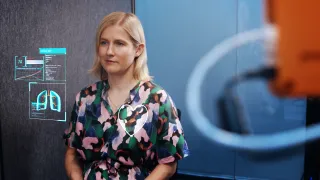An intelligent system will only be able to monitor your health, safeguard you through traffic or protect you on the factory floor among robots if the system is able to detect the world around. This means the intelligent system is provided with proper senses and reasoning capabilities. The recently launched DistriMuSe project will develop this with a variety of distributed and unobtrusive sensors to monitor people, to support human health, and improve safety in driving and traffic situations and in factory environments involving robots.
DistriMuSe is coordinated by VTT and brings together 50 partners from 7 countries to reach this ambitious goal. DistriMuSe resorts under the Chips Joint Undertaking, and the budget of approx. 35 M€ is co-funded by the European Commission and national funding agencies. The project started on the 1st of May 2024, and will run for three years. DistriMuSe project continues and extends the work started in the NextPerception project.
DistriMuSe intends to support human health and safety by improved sensing
Our everyday activities are assisted by a variety of technological devices more or less intelligent. Mobile phones, sport trackers, autonomous vacuum cleaners or factory robots, just to mention some. Seamless interaction with these devices offers great potential, but also sets technological challenges and harbours risks. In order to improve health and safety, devices must therefore be equipped with sensors and intelligence to really understand their human counterpart. This includes monitoring mental and physical states and recognising activities or intentions without neglecting privacy or data protection.
Enabling unobtrusive and continuous monitoring, sensing technologies like radar, lidar, camera-based and wearables are used. By deploying multiple sensors, the solutions will enable better coverage both in time and space, as well as improve accuracy. The vast amount of data generated by these multiple sensors will be combined (fused) and processed efficiently by distributing the necessary computations over available resources.
Leveraging home measurement-based diagnosis to solve health issues
In healthcare, the rising costs in Europe, due to e.g. the ageing population, necessitate a shift from reactive to proactive diagnosis and treatments. This will be greatly facilitated by technology which supports health monitoring at home, which helps to detect health issues early, call medical assistance or plan rehabilitation.
DistriMuse therefore targets monitoring sleep, activity, exercise and gait to monitor overall health trends, decline in cognitive abilities (MCI), sleep quality or physical performance. Sleep-related diseases may, for example, be detected before they affect an individual’s daily living quality or work efficiency. To achieve this, the monitoring solution will need to be more cost effective and convenient than current laboratory-based studies, while providing the same level of clinical accuracy.
Protecting pedestrians and cyclists with automated traffic solutions
The single greatest risk in traffic is posed by the person behind the wheel, especially when drowsy. Driver monitoring systems (DMS) monitoring the vigilance of the drivers are required in all new vehicles in Europe from 2024 onward to decrease accidents.
While drivers will be better protected, the safety of vulnerable road users (VRU) (e.g pedestrians, bikers) remain at the mercy of drivers and increasingly automated vehicles. DistriMuse’s solution for this are sensor systems monitoring the VRUs in traffic as well as the drivers, and methods to integrate information from cars and road-side sensors, to obtain a holistic picture of the situation. This will lay a base for the expected future integration of DMS and Advanced Driving Assistance Systems (ADAS).
Enabling safe human-robot interaction in a factory environment
In manufacturing automation robots have long ago taken over simple and repetitive tasks, with humans remaining at a safe distance from robots to avoid injury. The next breakthrough will be enabled by intelligent collaborating robots (cobots), which interact naturally with human workers sharing the same space. Smooth interaction will permit tackling more complex tasks including item hand-over or working simultaneously together.
For example, in office work this trend happens already, as intelligent assistants such as ChatGPT and Copilot perform dedicated tasks. DistriMuSe will harness people monitoring technologies similar to those used in the healthcare and traffic domains to enhance the human-robots interaction by developing the understanding of the human intention. This will allow the robot to pro-actively avoid any safety risk while continuing task execution.

